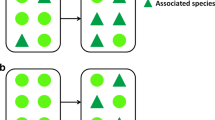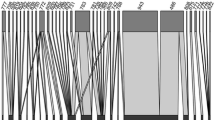Abstract
Plant monocultures are commonly believed to be more susceptible to herbivore attacks than stands composed of several plant species. However, few studies have experimentally tested the effects of tree species diversity on herbivory. In this paper, we present a meta-analysis of uniformly collected data on insect herbivore abundance and damage on three tree species (silver birch, black alder and sessile oak) from seven long-term forest diversity experiments in boreal and temperate forest zones. Our aim was to compare the effects of forest diversity on herbivores belonging to different feeding guilds and inhabiting different tree species. At the same time we also examined the variation in herbivore responses due to tree age and sampling period within the season, the effects of experimental design (plot size and planting density) and the stability of herbivore responses over time. Herbivore responses varied significantly both among insect feeding guilds and among host tree species. Among insect feeding guilds, only leaf miner densities were consistently lower and less variable in mixed stands as compared to tree monocultures regardless of the host tree species. The responses of other herbivores to forest diversity depended largely on host tree species. Insect herbivory on birch was significantly lower in mixtures than in birch monocultures, whereas insect herbivory on oak and alder was higher in mixtures than in oak and alder monocultures. The effects of tree species diversity were also more pronounced in older trees, in the earlier part of the season, at larger plots and at lower planting density. Overall our results demonstrate that forest diversity does not generally and uniformly reduce insect herbivory and suggest instead that insect herbivore responses to forest diversity are highly variable and strongly dependent on the host tree species and other stand characteristics as well as on the type of the herbivore.



Similar content being viewed by others
References
Andow DA (1991) Vegetational diversity and arthropod population response. Annu Rev Entomol 36:561–586
Baier P, Führer E, Kirisits T, Rosner S (2002) Defence reactions of Norway spruce against bark beetles and the associated fungus Ceratocystis polonica in secondary pure and mixed species stands. For Ecol Manage 159:73–86
Belyea HC (1923) The control of white pine weevil (Pissodes strobi) by mixed planting. J For 21:384–390
Boege K, Marquis RJ (2005) Facing herbivory as you grow up: the ontogeny of resistance in plants. Trends Ecol Evol 20:441–448
Bommarco R, Banks JE (2003) Scale as modifier in vegetation diversity experiments: effects on herbivores and predators. Oikos 102:440–448
Cates RG (1980) Feeding patterns of monophagous, oligophagous, and polyphagous insect herbivores: the effect of resource abundance and plant chemistry. Oecologia 46:22–31
Elton CS (1958) The ecology of invasions by animals and plants. Chapman & Hall, London
Feeny P (1970) Seasonal changes in oak leaf tannins and nutrients as a cause of spring feeding by winter moth caterpillars. Ecology 51:565–581
Finch S, Collier RH (2000) Host-plant selection by insects—a theory based on ‘appropriate/inappropriate landings’ by pest insects of cruciferous plants. Entomol Exp Appl 96:91–102
Futuyma DJ, Wasserman SS (1980) Resource concentration and herbivory in oak forests. Science 210:920–922
Goodman D (1975) Theory of diversity-stability relationships in ecology. Q Rev Biol 50:237–266
Graham SA (1959) Control of insects through silvicultural practices. J For 57:281–283
Gurevitch J, Hedges LV (1993) Meta-analysis: combining the results of independent experiments. In: Scheiner SM, Gurevitch J (eds) Design and analysis of ecological experiments. Chapman & Hall, New York, pp 378–398
Gurevitch J, Curtis PS, Jones MH (2001) Meta-analysis in ecology. Adv Ecol Res 32:199–235
Hambäck PA, Beckerman AP (2003) Herbivory and plant resource competition: a review of two interacting interactions. Oikos 101:26–37
Hambäck PA, Englund G (2005) Patch area, population density and the scaling of migration rates: the resource concentration hypothesis revisited. Ecol Lett 8:1057–1065
Harper JL (1989) The value of a leaf. Oecologia 80:53–58
Hespenheide HA (1991) Bionomics of leaf-mining insects. Annu Rev Entomol 36:535–560
Jactel H, Brockerhoff E, Duelli P (2005) A test of the biodiversity-stability theory: meta-analysis of tree species diversity effects on insect pest infestations, and re-examination of responsible factors. In: Scherer-Lorenzen M, Körner C, Schulze E-D (eds) Forest diversity and function Ecological studies, vol 176. Springer, Berlin, pp 235–262
Klimetzek D (1990) Population dynamics of pine-feeding insects: a historical study. In: Watt AD, Leather SR, Hunter MD, Kidd NAC (eds) Population dynamics of forest insects. Intercept, Andover, pp 3–10
Koricheva J, Vehviläinen H, Riihimäki J, Ruohomäki K, Kaitaniemi P, Ranta H (2006) Diversification of tree stands as a means to manage pests and diseases in boreal forests: myth or reality? Can J For Res 36:324–336
MacArthur R (1955) Fluctuations of animal populations and a measure of community stability. Ecology 36:533–536
McCann KS (2000) The diversity-stability debate. Nature 405:228–233
Miller A, Rusnock P (1993) The rise and fall of the silvicultural hypothesis in spruce budworm (Choristoneura fumiferana) management in eastern Canada. For Ecol Manage 61:171–189
Moore R, Francis BJ (1991) Factors influencing herbivory by insects on oak trees in pure stands and paired mixtures. J Appl Ecol 28:305–317
Moore R, Warrington S, Whittaker JB (1991) Herbivory by insects on oak trees in pure stands compared with paired mixtures. J Appl Ecol 28:290–304
Murakami M, Yoshida K, Hara H, Toda MJ (2005) Spatio-temporal variation in lepidopteran larval assemblages associated with oak, Quercus crispula: the importance of leaf quality. Ecol Entomol 30:521–531
Niemelä P (1983) Seasonal patterns in the incidence of specialism: macrolepidopteran larvae on Finnish deciduous trees. Ann Zool Fenn 20:195–202
Otway SJ, Hector A, Lawton JH (2005) Resource dilution effects on specialist insect herbivores in a grassland biodiversity experiment. J Anim Ecol 74:234–240
Pimentel D (1961) Species diversity and insect population outbreaks. Ann Entomol Soc Am 54:76–86
Riihimäki J, Kaitaniemi P, Koricheva J, Vehviläinen H (2005) Testing the enemies hypothesis in forest stands: the important role of tree species composition. Oecologia 142:90–97
Riipi MP, Ossipov VP, Lempa KP, Haukioja EP, Koricheva JP, Ossipova SP, Pihlaja KP (2002) Seasonal changes in birch leaf chemistry: are there trade-offs between leaf growth and accumulation of phenolics? Oecologia 130:380–390
Rodriguez-Saona C, Thaler JS (2005) Herbivore-induced responses and patch heterogeneity affect abundance of arthropods on plants. Ecol Entomol 30:156–163
Root RB (1973) Organization of a plant-arthropod association in simple and diverse habitats: the fauna of collards (Brassica oleracea). Ecol Monogr 43:95–124
Rosenberg MS, Adams DC, Gurevitch J (2000) MetaWin: statistical software for meta-analysis, version 2.0. Sinauer Assoc, Sunderland
SAS (1999) SAS/STAT user’s guide, version 8. SAS Institute, Cary, N.C.
Scherer-Lorenzen M, Potvin C, Koricheva J, Schmid B, Hector A, Bornik Z, Reynolds G, Schulze ED (2005) The design of experimental tree plantations for functional biodiversity research. In: Scherer-Lorenzen M, Körner C, Schulze E-D (eds) Forest diversity and function: temperate and boreal systems. Ecological studies, vol 176. Springer, Berlin, pp 347–376
Summerville KS, Conoan CJ, Steichen RM (2006) Species traits as predictors of lepidopteran composition in restored and remnant tallgrass prairies. Ecol Appl 16:891–900
Tahvanainen JO, Root RB (1972) The influence of vegetational diversity on the population ecology of a specialized herbivore, Phyllotreta cruciferaea (Coleoptera: Chrysomelidae). Oecologia 10:321–346
Thébault E, Loreau M (2005) Trophic interactions and the relationship between species diversity and ecosystem stability. Am Nat 166:95–114
Tonhasca AJ, Byrne DN (1994) The effects of crop diversification on herbivorous insects: a meta-analysis approach. Ecol Entomol 19:239–244
Tscharntke T, Brandl R (2004) Plant–insect interactions in fragmented landscapes. Annu Rev Entomol 49:405–430
Tylianakis JM, Didham RK, Wratten SD (2004) Improved fitness of aphid parasitoids receiving resource subsidies. Ecology 85:658–666
Tylianakis JM, Klein A-M, Tscharntke T (2005) Spatiotemporal variation in the diversity of Hymenoptera across a tropical habitat gradient. Ecology 86:3296–3302
Vehviläinen H, Koricheva J (2006) Moose and vole browsing patterns in experimentally manipulated pure and mixed forest stands. Ecography 29:497–506
Vehviläinen H, Koricheva J, Ruohomäki K, Johansson T, Valkonen S (2006) Effects of tree stand species composition on insect herbivory of silver birch in boreal forests. Basic Appl Ecol 7:1–11
White JA, Whitham TG (2000) Associational susceptibility of cottonwood to a box elder herbivore. Ecology 81:1795–1803
Acknowledgements
We are grateful to Samuli Helle, Pekka Kaitaniemi, Andre Koppe, Liisa Laukkanen, Elina Mäntylä, Aila Oravala, Henna Piekäinen, Janne Riihimäki, Paula Salminen, Lassi Suominen and Elena Valkama for their help in collecting and handling the vast amount of data. We thank the staffs of the Satakunta Environmental Research Institute of University of Turku and the Östad field station of the Swedish University of Agricultural Sciences for their hospitality. The study was financially supported by the Academy of Finland (project 76735), the Finnish Society of Forest Science, the Satakunta Cultural Foundation and the Turku University Foundation (grants to HV).
Author information
Authors and Affiliations
Corresponding author
Additional information
Communicated by Diethart Matthies.
Rights and permissions
About this article
Cite this article
Vehviläinen, H., Koricheva, J. & Ruohomäki, K. Tree species diversity influences herbivore abundance and damage: meta-analysis of long-term forest experiments. Oecologia 152, 287–298 (2007). https://doi.org/10.1007/s00442-007-0673-7
Received:
Accepted:
Published:
Issue Date:
DOI: https://doi.org/10.1007/s00442-007-0673-7




